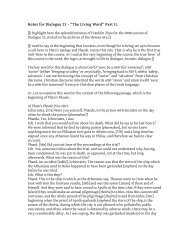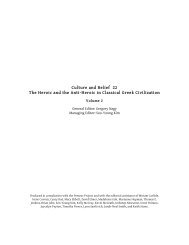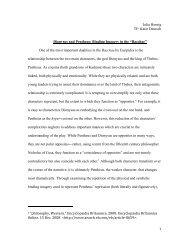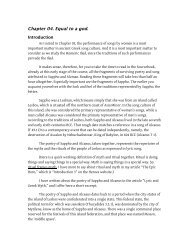You also want an ePaper? Increase the reach of your titles
YUMPU automatically turns print PDFs into web optimized ePapers that Google loves.
Message from Gregory Nagy about the first assigned paper for the course about<br />
concepts of the hero in Greek civilization. Part I features general suggestions. Part II<br />
has specific suggestions on how to write your paper.<br />
Part I.<br />
For your assigned paper, you are asked to focus on a passage or scene from your<br />
readings in ancient Greek literature so far in this course and compare it with one aspect<br />
or detail of the film sequence screened on Tuesday 9 October 2007 at 6:30 in Emerson<br />
105 (as announced in the Syllabus for the Heroes course), with additional screenings on<br />
Wednesday 10 October at 6:30 (Yenching Auditorium) and Tuesday 16 October at 6:30<br />
(Yenching Audiorium).<br />
After each one of the first two screenings, I led a discussion of the film<br />
sequence. Each time it lasted about half an hour. I consider our after-viewing discussion<br />
to be a vital part of the overall experience of movie night. There will also be a<br />
discussion with me after the third screening.<br />
After the third screening, we will place a copy of the film sequence on reserve in<br />
Lamont, so that people may have a chance to take another look at it as they write their<br />
papers.<br />
Here is some background on the film sequence, which will require a close<br />
"reading" on your part - comparable to your close reading of Greek literature. In what<br />
follows, I give you some background about what we will see and hear in the film<br />
sequence. I also indicate how the medium of opera - especially the opera that I will be<br />
highlighting - is important for helping you develop the special reading skills you need<br />
for this course.<br />
The highlighted opera is Tales of Hoffmann (in the original French, Les Contes<br />
d'Hoffmann), an opéra fantastique with music composed by Jacques Offenbach (premiered<br />
in 1881). This opera was based on an original play by Jules Barbier and Michel Carré<br />
(premiered in 1851), which in turn was based on a set of short stories by E. T. A.<br />
Hoffmann (published in the early 1800s). These short stories center on the tragic loves<br />
of romantic heroes (as they were known in the early 1800s).<br />
Our viewing of selected sequences taken from this opera is supplemented with a<br />
brief set of two sequences taken from another opera by Offenbach, La Belle Hélène<br />
(premiered in 1864), which is an opéra bouffe based on ancient Greek narratives about<br />
the abduction of Helen by Paris a.k.a. Alexandros (= Alexander). This form of opera<br />
helps us understand better the experimental nature of Offenbach's Hoffmann, which is a<br />
most unusual mix of comic and serious operatic elements.<br />
1
For the screenings, the "video" and the "audio" of the Tales of Hoffmann are<br />
taken from two film versions of the opera. The earlier version was made in 1951 while<br />
the later version was made thirty years later, in 1981. Most of what we will be viewing<br />
comes from the earlier version, a film produced and directed by Michael Powell and<br />
Emeric Pressburger. This 1951 version is not only an opera: it is also a film - in the sense<br />
of an art form that is actually thought to be an art form by the film-makers who made<br />
it. As for the 1981 version, it is considered by some to be the best production of<br />
Offenbach's Hoffmann - ever. As an art form, however, this version is simply an opera<br />
that was preserved for posterity by way of video as well as audio recording.<br />
Here is a composite of the film sequences featured at the three screenings:<br />
1) A viewing of Chapters 1 and 10 from a film version (2000) of Offenbach's La Belle<br />
Hélène, sung in the original French with subtitles in English.<br />
2) A viewing of Chapters 1 3 4 5 of the 1951 film version of Offenbach's Tales of Hoffmann,<br />
sung in English from an English translation of the original French libretto. This<br />
sequence corresponds to the Prologue of the original opera, which is Act 1 of the<br />
original play.<br />
3) A viewing of Chapters 6-15 of the 1951 film version. This sequence corresponds to<br />
Act 1 of the original opera, which is Act 2 of the original play. Alternatively, a viewing<br />
of Chapters 6-13 of the 1981 film version of Hoffmann, sung in the original French with<br />
subtitles in English.<br />
4) A viewing of Chapters 16-30 of the 1951 film version. This sequence corresponds to<br />
Acts 2 and 3 and the Epilogue of the original opera, which are Act 3 and 4 and 5 of the<br />
original play.<br />
5) A viewing of Chapter 27 of the 1981 film version. This sequence corresponds to the<br />
Epilogue of the original opera, which is Act 5 of the original play.<br />
At the first screening, the Tale of Olympia (Act 1 of the original opera, which is Act 2 of<br />
the original play) was not viewed at all. The same goes for the second screening. Also,<br />
at the second screening, the Tale of Antonia (Act 3 of the original opera) was viewed in<br />
the 1981 rather than the 1951 version. At the third screening all three Tales (Olympia,<br />
Giulietta, Antonia) are are to be viewed in the 1951 version..<br />
All three screenings end with Chapter 27 of the 1981 film version.<br />
We see in the 1981 film version of the Epilogue a fuller reconstruction than what we see<br />
in the 1951 film version, which makes a forceful statement indicating the view of the<br />
2
conductor, Sir Thomas Beecham, that he wants to end the narrative where it actually<br />
ends in the 1951 version - and that there must be no argument about it. He forcefully<br />
slams down his baton at the end of his performance, indicating that the end of the<br />
composition must come exactly at this point. And then, right after this point in the film<br />
narrative, the lettering on the screen arrives to reinforce the artistic judgment of the<br />
authoritarian performer: "The End"!<br />
The forceful gesture of Sir Thomas is in line with the fact that the makers of the<br />
1951 film thought that the performance should stop at the point marked as "The End"!<br />
In what follows, I mention some passages from classical Greek literature that<br />
students might choose as points of comparison with details they notice in the film<br />
sequence. Such details can include (but are not limited to) narrative technique,<br />
characterization, metaphor, the role of emotions, and the interplay of humor and<br />
seriousness. For a comparison of the metaphor of refraction in The Tales of Hoffmann and<br />
a poem of Sappho, you may want to look at my article "The Fragmentary Muse and the<br />
poetics of refraction in Sappho, Sophocles, Offenbach," which I make available on the<br />
"Texts" page of the website.<br />
- The Judgment of Paris passage in Iliad XXIV 25-30. We see in this micronarrative the<br />
fatal moment when Paris is called upon to judge which one of three goddesses is the<br />
best of all goddesses. The three goddesses are Hera, Athena, and Aphrodite. Paris<br />
awards the prize to Aphrodite, at the expense of Hera and Athena. In return for doing<br />
so, Aphrodite arranges for him to win the sexual favors of Helen. In La Belle Hélène<br />
Chapter 10, we see and hear Paris himself sing the story of his Judgment. In the<br />
background, we see silhouettes of the three goddesses. Notice that the goddesses, to<br />
judge by their silhouettes, are colossal in size compared to the mortal Paris. Such a<br />
colossal view of the divine is typical of the ancient Greek mind set. In true French<br />
classicist style, Paris names the goddesses in Latin: Hera is Juno, Athena is Minerva, and<br />
Aphrodite is Venus. The prize, in the version sung by the Paris figure, is an apple. This<br />
theme of the "apple of discord" is classical, though it is not mentioned in the<br />
micronarrative of the Iliad.<br />
- The "apple" fragment of Sappho:<br />
Sappho 105a [tr. Julia Dubnoff] (via Syrianus on Hermogenes, On Kinds of Style)<br />
Like a sweet-apple / turning red / high / on the tip / of the topmost branch./<br />
Forgotten by pickers. // Not forgotten - / they couldn’t reach it.<br />
- Also relevant is this piece of information about the poetry of Sappho:<br />
3
Sappho 105b (via Himerius Orations 1.16):<br />
“Sappho compared the girl to an apple....she compared the bridegroom to Achilles, and<br />
likened the young man’s deeds to the hero’s.”<br />
Here are some other ideas concerning points of comparison you can find between<br />
details in the film sequence and details in your reading of the Homeric Iliad.<br />
- With reference to the audio micronarrative of Phoenix in Iliad IX or the video<br />
micronarrative about the Shield of Achilles in Iliad XVIII, you could write an essay<br />
comparing the interaction of micro- and macronarratives in the Iliad with similar<br />
interactions in the Tales of Hoffmann.<br />
Here is just one of many examples of how you plan such an essay. It is the "Tale<br />
of Kleinzach" (the name Kleinzach means 'little Zachary'), which is a micronarrative<br />
embedded in the Prologue. Kleinzach is a grotesque dwarf who makes people laugh at<br />
his grotesquerie. In the "Tale of Kleinzach," the dwarf falls in love with a beautiful<br />
prima donna - in the 1951 film version of Tales, this prima donna is played by an artist<br />
who was a prima ballerina in "real life," Moira Shearer. Here is a tale of unrequited<br />
love, which can be comic - or tragic, as it turns out. The rowdy students who are the<br />
audience of the "poet" Hoffmann are expecting him to sing a comic version of the tale.<br />
But Hoffmann's micronarrative becomes tragic while he is singing it. That is because<br />
the macronarrative of his own loves as a romantic hero is tragic, not comic. So<br />
Hoffmann's micronarrative about Kleinzach is deflected as he becomes more and more<br />
involved in the emotions of the dwarf, and his focus shifts to the prima donna, who is<br />
comparable to a prima donna loved by Hoffmann himself in the macronarrative. The<br />
name of that prima donna loved by Hoffmann is Stella, which means 'the star', and I<br />
will have more to say about her later. For now I focus on the love of Hoffmann, which is<br />
unrequited by Stella - as we find out only at the end of the opera. Hoffmann's<br />
micronarrative about the unrequited love of Kleinzach for his prima donna is deflected<br />
by the macronarrative about his own unrequited love for Stella. An obvious point of<br />
comparison is the way in which the focus of the micronarrative of Phoenix is deflected<br />
from the comrades of Meleager to his wife, Kleopatra - all because of the focus that<br />
prevails in the macronarrative of the Iliad.<br />
I close with an interesting detail about the camera angle in the 1951 film version<br />
at the moment when Hoffmann's song about Kleinzach reaches its climactic declaration<br />
of the poet's love for Stella. In this moment of musical passion, the flame emanating<br />
from the punch bowl is positioned immediately behind the head of the poet, as if it<br />
were his "halo"! I am reminded of the "halo" effect behind the head of Achilles at<br />
4
climactic moments of the hero's passion in the Iliad. These "halo" effects are of course<br />
not related to each other, but they are certainly comparable.<br />
Part II. Specific suggestions on how to write your paper.<br />
The cardinal rule for success in writing papers for my course on Heroes is this:<br />
analyze, don’t just retell.<br />
Your paper needs to argue something, and you need to say what you will argue at the<br />
beginning. That is why it is wise to make sure you have lined up your argumentation<br />
before you ever write your first paragraph.<br />
In this particular paper, you need to make meaningful connections between what you<br />
have already read – especially the epic of the Iliad and the songs of Sappho – and what<br />
you will be “reading” when you view the screening of the film sequences from two<br />
operas by Offenbach. Remember: the things you are connecting are not historically<br />
related to each other. Rather, as I said to you earlier, they are simply worth comparing<br />
with each other. And what makes unrelated things comparable? It is simply the fact<br />
that the act of comparison helps you see something more clearly than before.<br />
If you have not done your assigned readings already, it will be very difficult for you to<br />
make any meaningful connections with what you will be viewing in the film sequence.<br />
If you find yourself in such a difficult situation, the very least you can do is to master<br />
some part of the assigned reading of the Iliad and the songs of Sappho - and then try to<br />
make connections on the basis of at least that much background when you write your<br />
essay. Of course the students who have done all their assigned reading will still have a<br />
big advantage over you, since they will have a far better command of the things that<br />
are obviously comparable. And they will have more freedom of choice in finding details<br />
in the Iliad or in the songs of Sappho that they can compare with details they notice in<br />
the course of their viewing the film sequence. Still, even if you can only master some of<br />
the assigned reading so far, it would be at least a start for you, and it would still be<br />
better than trying to write an essay without having done any of the assigned readings. I<br />
should add that our TFs are very sympathetic to people who are making a genuine<br />
effort to catch up.<br />
To give you an idea of the level of support that you are getting form your TFs, I quote<br />
the words of one of our TFs, Sally Livingston, writing in response to worries expressed<br />
by "student X" in one of her sections:<br />
Dear X and the whole Heroes crew,<br />
I think your concerns are shared by a number of students, so thanks for putting<br />
5
them out there so that we can all brainstorm on how best to make this paper a<br />
fruitful experience. You are quite right to understand that the course<br />
involves two levels of learning: the first is pure philology: what did these<br />
words MEAN (quite beyond a simple definition) to the Greeks? The second, how<br />
can we TRANSLATE these concepts in a such a way that we can understand them<br />
today? That is the role of the film clips in dialogues. In this paper, you<br />
are all asked to do an additional translation: take a musical expression of<br />
some of the Heroes concepts which is not a direct telling of the story and<br />
relate it to the readings. Your sense of "the feeling, the feeling" is<br />
absolutely key to this process. Our role as teachers is to help you find the<br />
way to take what is your non-verbal understanding of this connection and help<br />
you translate it into words. What I have found this week when I have been<br />
meeting with students one-on-one is that they come in with a similar vague<br />
sense of connection and leave with an idea that they can run with. It's all<br />
part of the dialogue of the Heroes course. So let's meet early in the week and<br />
get you going on this process. I'm bringing a sign-up sheet for extra office<br />
hours to dialogue on Monday and I'm sure we'll find a time.<br />
Have a lovely weekend,<br />
Sally<br />
About what to look for in finding things to compare between the assigned readings and<br />
the film viewing.<br />
I suggest that you think small. Start with a sharp focus on something that you have<br />
noticed that is worth comparing. It can involve the smallest detail - so long as you make<br />
a good argument.<br />
I have given you some ideas about the kinds of detail I have in mind. A case in point is<br />
the "halo effect" when you experience the optical illusion of seeing a flame shooting<br />
out of the poet's head in the Prologue of the 1951 film version of Tales of Hoffmann.<br />
There are passage in the Iliad, as I said earlier, that feature a similar "halo effect"<br />
involving the hero Achilles. If you choose this particular topic, though, you obviously<br />
won't get much credit for originality. So my examples are not meant to be merely<br />
copied by you. Rather, there are meant as simply that, examples that will give you ideas<br />
of what similar things you might find. Again, it is a matter of making mental<br />
connections. That is the kind of reading you have to do for this course.<br />
One possible source for finding things is the essay of mine that I share with you on the<br />
"Texts" page of the course website, "The Fragmentary Muse." From a reading of this<br />
essay, you will find many details that you can pursue on your own. It is perfectly all<br />
right for you to take details from this essay - either about the operas or about the<br />
assigned readings. Just make sure, though, that you don't copy my arguments as well.<br />
You have to make your own arguments with whatever details you find.<br />
6
Here is one example... In my essay, I quote from a short story by E. T. A. Hoffmann a<br />
detail about an opinion expressed by a pompous professor of poetry and rhetoric. It<br />
concerns the "moral of the story" about the unrequited love of the romantic hero<br />
Nathanael for the doll-woman Olympia. He speaks about the "rabbit in the pepper" - as<br />
if there were some obvious answer to the meaning of the story of Nathanael's<br />
unrequited love. You could ask yourself: how is this narrative device comparable to the<br />
ainos in ancient Greek epic? I could see many interesting possibilities for how to write<br />
an essay about such a topic. If you were to choose such an essay, though, you would<br />
have to make double sure that you are original in what you are arguing. There are<br />
many opportunities for originality here. But you must be original, not derivative.<br />
7










